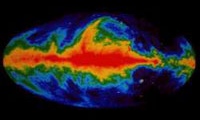Accept
Details & settings
This website uses cookies for cookie consent and statistics.

Radio astronomy is one of the most interesting areas of astronomy, however, conducting real radio astronomy is a major undertaking requiring at least an antenna, a receiver and a data recorder. In addition to this, accurate observations also require a tracking system and a computer for data processing. This is why radio astronomy is out of reach for most schools and normal people.
Fortunately, my former school had been given a 1.7 m parabolic mirror including tracking system and receiver by the Max-Planck-Institute for Radio Astronomy (MPIfR). This equipment formed the basis of a club that conducted many interesting experiments and won several awards.
How might someone do radio astronomy with little effort? This question kept coming up in conversations with other schools, teachers and students. Motivated by a request from MPIfR to return the telescope, we have been looking into possible solutions. There were many approaches, e.g. the world's smallest radio telescope by Mario Simons, Gerd Nolden and Silke Kremer consisting of a 35 cm parabolic mirror and an amplifier, which can be constructed with fairly little effort. However, due to its small size, this little telescope is only suitable for solar observations.
My project is an attempt to make the entire radio sky available for radio astronomical observations by anyone. I have created the radio sky based on measurements from the radio telescopes Effelsberg, Jodrell Banks and Parkes. Furthermore, I have written a program that allows the user to measure this virtual radio sky using a virtual radio telescope. Radio sources can be detected with a resolution of 3.4 arc minutes.